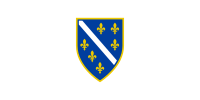Lilium bosniacum
| Lilium bosniacum | |
|---|---|
| File:Ljiljan1pc.jpg | |
| Scientific classification | |
| Kingdom: | |
| (unranked): | |
| (unranked): | |
| Order: | |
| Family: | |
| Genus: | |
| Species: | Lilium bosniacum
|
| Binomial name | |
| Lilium bosniacum | |
Lilium bosniacum is a lily native to Bosnia and Herzegovina. It's also known as Zlatni ljiljan (Bosnian for Golden lily) and Bosanski ljiljan (Bosnian lily).
L. bosniacum has often been lumped and splitted and lumped again. Some results of molecular studies [1] support it as an infraspecific taxon of Lilium carniolicum.
Lilium bosniacum, together with Lilium albanicum and Lilium jankae have always been treated as varietes of Lilium carneolicum. However, extensive DNA-analyses[2][3] have shown that this group is polyphyletic. Therefore, on The Genus Lilium they are treated as separate species.
Description
Lilium bosniacum Beck ex Fritsch 1909 Section 3b Syn.: L. carniolicum var. bosniacum
Bulb: ovoid, 6-7 cm in diameter, yellowish.
Stem: 30-90 cm.
Leaves: densely scattered, horizontal with tips curved upwards, narrowly lanceolate with slightly hairy margins.
Flowers: 1-6 in a raceme, nodding, fragrant. Tepals strongly revolute, typical turk´s cap-shape, wax-like texture, yellow to orange WITHOUT spots, ~6 cm in diameter. Seeds delayed hypogeal germination. Flowering time ~July. 2n=24.
Origin: Bosnia and Herzegovina.
Symbolism

The Golden Lily is a symbol of Bosnian Kingdom, Bosnia and Bosniak people. It has been used in the Bosnian kingdom on flags and coat's of arms. The Coat of arms created by the royal family Kotromanić consisted of six golden lilies on a blue background with a white ribbon. After Bosnia and Herzegovina gained independence from Yugoslavia on March 1st 1992. Lily's were brought back on the Bosnian flag. The flag of the Republic of Bosnia and Herzegovina consisted of the coat of arms of golden lilies on a white background. Even though lily's are also a symbol of Christianity, Bosniaks, who are in vast majority Muslims, use it as their symbol. It's also used in mosques and on gravestones as decoration.
In 1998. after the protests of political representatives of the former Herceg-Bosna and Republika Srpska, the flag of the Republic of Bosnia and Herzegovina was replaced. However Bosnian's continue to use the coat of arms and flag with lilies in the appropriate cultural conditions, and on the coat of arms of the Federation of BiH and the coats of arms of some cantons and municipalities, the lily is used as a symbol of Bosniaks.
References
- ^ I. Resetnik, Z. Liber, Z. Satovic, P. Cigic, T. Nikolic: Molecular phylogeny and systematics of the Lilium carniolicum group (Liliaceae) based on nuclear ITS sequences, in: Plant Systematics and Evolution, 265: 45–58 (2007)
- ^ Nursel Ikinci, Christoph Oberprieler, Adil Güner: On the origin of European lilies: phylogenetic analysis of Lilium section Liriotypus (Liliaceae) using sequences of the nuclear ribosomal transcribed spacers, In: Willdenowia 36, 2006, p. 647-656.
- ^ Muratović, E., Bogunić, F., Soljan, D., & Siljak-Yakovlev, S. 2005: Does Lilium bosniacum merit species rank? A classical and molecular-cytogenetic analysis. – Pl. Syst. Evol. 252: 97-109.
